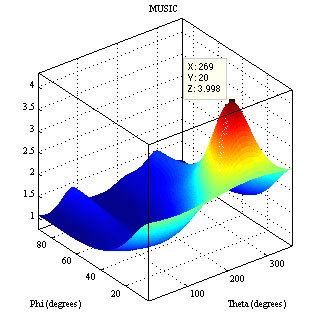Analog and Digital Boards
An analog pre-amplifier and bandpass filter board is fabricated for signal amplification and noise attenuation. The analog signal is digitally sampled at a rate of 250 kS/s by a NI (National Instruments) NI9223 Analog Input Module (DAQ). Array signal processing algorithms are programmed with Lab-VIEW 2012 on NI sbRIO NI9206 (FPGA). The FPGA transmits the computed FFT (Fast Fourier Transform) information to the SBC via the UDP protocol, where the MUSIC algorithm is performed.
Algorithm
The sampled signal is passed into an elliptic 10th order band pass filter with a center frequency set to the pinger’s frequency. This digital filter has a narrow 3 dB bandwidth of 5 kHz. The start of each ping must be correctly identified before information on its phase can be computed. This is estimated using the peak and dynamic threshold detection. Dynamic thresholding is preferred over simple thresholding because the received power varies with distance. Only the initial segment of the ping (Line of Sight signal) is extracted for post processing. This avoids phase distortion when multipath reverberation effects set in at a later stage. The amount of samples extracted is defined by a FFT size of 128 points determined by extensive experimentation.
FFT-operations are performed on the extracted ping to verify that the identified signal falls within the frequency range of the pinger. If the signal falls within the defined frequency range, the complex numbers (FFT points) associated with the peaks of the power spectrum are extracted. These FFT points are used to compute the covariance matrix required in the MUSIC algorithm.
In this application, the spatial covariance matrix is computed over a period of 3 pings. The eigenvectors corresponding to the signal and noise subspaces are obtained from eigen-decomposition of the spatial covariance matrix. The MUSIC algorithm searches for a set of azimuth θ and elevation -ø where the array steering vector ∝ (-ø; θ) is the most orthogonal to the noise eigenvectors Vn. The direction of the pinger is indicated by the maximum point of Pmusic derived from the 2-D search in θ and -ø.
